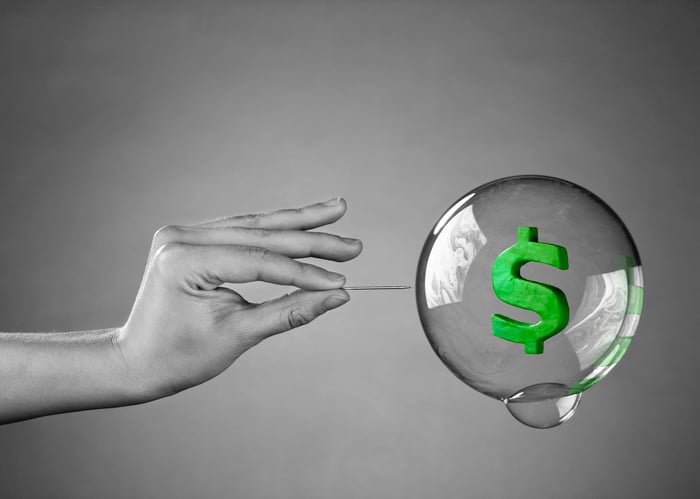
One week from today, we’ll turn the page on what’ll certainly be another successful year for investors. The broad-based S&P 500 was higher by a cool 22% through Dec. 20, which effectively doubles up its average annual total return, including dividends, over the past four decades.
But the gains have been even more robust for cryptocurrency investors. With an aggregate market value of $2.2 trillion, the total value of all cryptocurrencies has surged higher by 184% in 2021.
Shiba Inu-themed coins have been incredibly popular in 2021. Image source: Getty Images.
Dogecoin has delivered life-altering gains since Dec. 2013
Yet if you focus on the most popular digital currencies and pan out a bit further, the gains become even more impressive.
Take meme coin Dogecoin (CRYPTO:DOGE) as an example. Pretty much any cryptocurrency that’s utilized the Shiba Inu dog breed as its inspiration or the face of its campaign performed exceptionally well in 2021. At one point, Dogecoin had gained approximately 27,000% in just a six-month stretch between early November 2020 and early May 2021.
But the gains have been even bigger for patient holders of DOGE. Looking back eight years, CoinMarketCap.com notes that a single DOGE token could be purchased for $0.0004512. But as of the time of this writing, Dogecoin was trading hands for $0.1676. In eliminating three zeroes, one of the most-popular digital currencies on the planet gained more than 37,000%.
To put this into context, if investors purchased $100 worth of Dogecoin on Dec. 22, 2013 and simply held through periods of wild volatility, they’d be sitting on $37,145 today. That’s a higher aggregate total return than the S&P 500 since the beginning of 1965 — and it took 48 fewer years to achieve this superior return.

Image source: Getty Images.
Here’s what’s driven Dogecoin more than 37,000% higher
Numerous catalysts have lit a fire under Dogecoin over the past eight years. However, most of its upside momentum can be traced to the past 12 months.
The most clear and obvious catalyst for Dogecoin is the support of Tesla Motors‘ (NASDAQ:TSLA) CEO Elon Musk. The self-proclaimed “Dogefather” is no stranger to tweeting out Shiba Inu-themed memes that imply Dogecoin can “go to the moon.” Dogecoin happens to be one of the three cryptocurrencies currently owned by the world’s richest person.
To build on the previous point, Musk has also tweeted that he’d be working with Dogecoin’s developers to improve the blockchain-based network and make it more competitive.
Dogecoin’s investors are rallying around its growing utility, too. Online business directory Cryptwerk notes that nearly 2,000 merchants now accept Dogecoin as a form of payment. Additionally, DOGE is being accepted for select merchandise at Tesla, and is one of a small number of available crypto payment options online at movie-theater-chain AMC Entertainment.
The fear of missing out (FOMO) is clearly playing a role, as well. With crypto investors watching Bitcoin catapult more than 8,000,000,000% at one point in a little over 11 years, they’re of the belief that anything is possible. They’re especially attracted to the psychological target of DOGE reaching $1.
Lastly, I’d add that it’s a lot tougher to short-sell lesser-known cryptocurrencies than it is to bet against Bitcoin or publicly traded stocks that have derivative trading options. With few channels to place downside bets on Dogecoin until recently, there was a natural buy bias in place that pushed its token price significantly higher.

Image source: Getty Images.
Dogecoin is one of the worst cryptocurrencies to buy
Though there are plenty of factors that have contributed to Dogecoin’s monumental run and online popularity, none of the aforementioned “catalysts” make DOGE worthy of your investment dollars or its $22 billion market value.
The biggest issue with the most searched cryptocurrency in the U.S. is that it has no competitive edge or true differentiation. With nearly 16,000 cryptocurrencies now listed on CoinMarketCap.com, blockchain projects and payment coins will need features that allow them to stand out from the crowd. Folks would like to think that social-media hype counts as a feature, but history tells us that emotion-based investing proves fleeting.
Although Dogecoin’s average transaction fees are lower than Bitcoin and Ethereum, its fees are also considerably higher than virtually all other popular payment coins. With so many other crypto payment coins offering faster block finality and transaction fees that are a fraction of that of Dogecoin, it makes little sense why Dogecoin would be a priority add for merchants.
This lack of competitive edge is readily apparent in Dogecoin’s merchant figures. It’s been eight years since its debut, and Dogecoin still hasn’t reached 2,000 merchants willingly accepting its token as payment.
But perhaps the most worrisome aspect of owning Dogecoin is what history tells us happens after quick, life-altering gains. Payment coins and network-based digital currencies that have gained at least 24,000% or more in a short time frame have seemingly all retraced by 93% to 99% in the subsequent 12-to-26 months after hitting their peak. Dogecoin is already down 77% from its May peak, and history suggests it has a ways to go before it has any chance of finding a bottom.
Despite Dogecoin’s popularity and big gains, investors should consider it one of the worst cryptocurrencies to buy for 2022 and beyond.
This article represents the opinion of the writer, who may disagree with the “official” recommendation position of a Motley Fool premium advisory service. We’re motley! Questioning an investing thesis — even one of our own — helps us all think critically about investing and make decisions that help us become smarter, happier, and richer.
This news is republished from another source. You can check the original article here

Be the first to comment